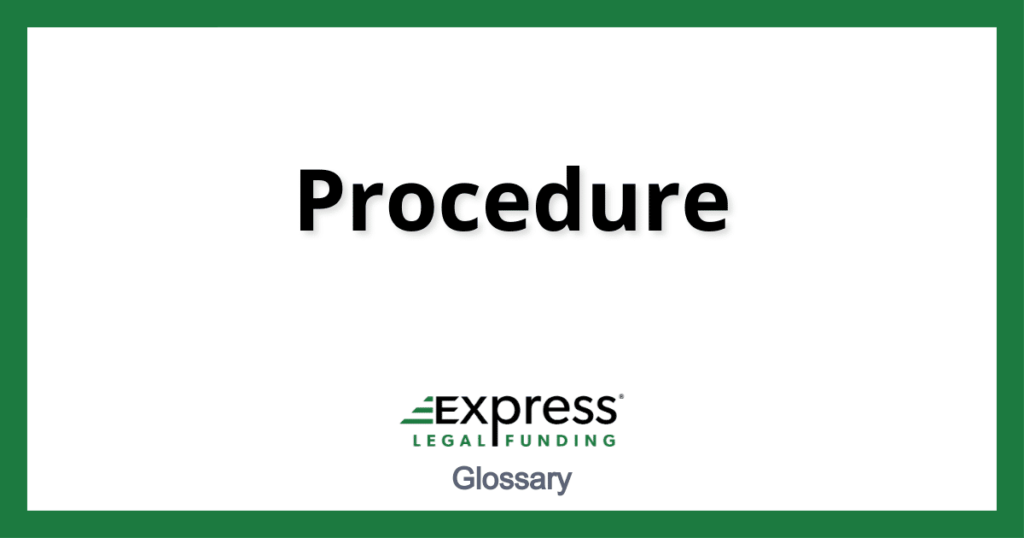The rules for conducting a lawsuit; there are rules of civil procedure, criminal procedure, evidence, bankruptcy, and appellate procedure.
What is a Legal Procedure?
A legal procedure refers to the formal steps and processes followed in a court of law to resolve a legal dispute or address a legal matter. It outlines the rules and guidelines that must be adhered to to ensure a fair and just resolution.
Legal procedures vary depending on the jurisdiction and the type of case being heard but generally involve several common elements.
These include filing a complaint or petition, serving notice to all parties involved, gathering evidence, presenting arguments and evidence in court, cross-examining witnesses, and receiving a final judgment or verdict.
Legal procedures are designed to uphold the principles of due process and provide a structured framework for resolving legal issues.
What is the Difference between Civil & Criminal Procedure?
Civil and criminal procedures are two distinct legal processes that govern different types of cases in a court of law. While both procedures aim to resolve disputes, they have several key differences.
Civil and criminal procedures differ in their purpose, burden of proof, potential outcomes, and procedural aspects, reflecting the distinct nature of the disputes they address.

Why are Procedural Rules Essential for Fair Legal Outcomes?
Adhering to procedural rules during a lawsuit can be challenging due to several factors. Some of the common challenges include:
- Complexity of rules: Procedural rules can be complex and extensive, varying from jurisdiction to jurisdiction. They often require a thorough understanding of legal terminology and technicalities, which can be difficult for individuals without legal training.
- Time constraints: Lawsuits generally have strict deadlines for filing documents, serving notices, and responding to motions. Adhering to these time constraints can be challenging, especially when dealing with multiple cases or a heavy workload.
- Procedural technicalities: Procedural rules often have strict requirements regarding the format and content of legal documents. Failure to comply with these technicalities can lead to the rejection of pleadings or other documents, causing delays and potential harm to a case.
- Procedural changes: Procedural rules can change over time due to legislative amendments or court decisions. Staying updated with these changes and ensuring compliance with the latest rules can be challenging, particularly for individuals not regularly involved in legal proceedings.
- Pro se litigants: Individuals representing themselves in a lawsuit, known as pro se litigants, face additional challenges in adhering to procedural rules. Without proper legal representation, they will find it difficult to navigate the complex regulations and will be at a disadvantage compared to opposing parties with legal expertise.
- Language barriers: For non-native English speakers or individuals unfamiliar with legal terminology, understanding and adhering to procedural rules can be particularly challenging. This can lead to misunderstandings, misinterpretations, and potential non-compliance with the rules.
- Judicial discretion and interpretation: Procedural rules are subject to judicial interpretation and discretion. Different judges may have varying interpretations of the rules, creating uncertainty and making it challenging to predict how a court will apply the rules in a particular case.
To overcome these challenges, it is often advisable to seek legal counsel to ensure proper adherence to procedural rules and navigate the litigation process’s complexities.
What is Appellate Procedure?
Appellate procedure refers to the rules and processes followed in appellate courts. When a party is dissatisfied with a decision made by a lower court, they may have the right to appeal it to a higher court. Appellate procedure outlines the steps and requirements for filing an appeal, presenting arguments, and seeking a review of the lower court’s decision.
What Happens if You Don’t Follow Legal Procedures?
If you don’t follow legal procedures, there can be various consequences depending on the specific situation and jurisdiction. Here are a few potential outcomes:
- Penalties and fines: Failing to follow legal procedures can result in penalties and fines imposed by the relevant authorities. These penalties can vary depending on the nature and seriousness of the violation.
- Dismissal of legal claims: If you don’t follow the prescribed legal procedures when filing a lawsuit or legal claim, the court may dismiss your case. This means your claim will not be heard, and you may lose the opportunity to seek legal remedies.
- Exclusion of evidence: In criminal proceedings, if legal procedures are not followed during the collection or presentation of evidence, it may be excluded from the trial. This can weaken the case against the accused or impact the trial outcome.
- Legal invalidation: Certain actions or contracts may be rendered legally invalid if proper procedures are not followed. For example, a contract may be deemed unenforceable if it does not comply with specific legal requirements.
- Loss of rights or entitlements: Failure to follow legal procedures can result in the loss of certain rights or entitlements. For example, if you follow the proper procedures when applying for a permit or license, you may be allowed the approval and the associated benefits.
What is the Legal Procedure for an Eviction?
The legal procedure for eviction can vary depending on the jurisdiction, but here is a general overview of the process:
- Provide Notice: The landlord must typically provide written notice to the tenant, stating the reason for the eviction and a specific timeframe to resolve the issue or vacate the premises. The notice period can vary depending on local laws and the reason for eviction (e.g., non-payment of rent, lease violation, etc.).
- Filing a Lawsuit: If the tenant fails to comply with the notice, the landlord may need to file a lawsuit, usually referred to as an “”unlawful detainer”” or “”eviction”” lawsuit, in the appropriate court. The landlord typically needs to complete the required forms and pay the filing fee.
- Serving the Tenant: After filing the lawsuit, the tenant must be served with a copy of the complaint and a summons, usually by a sheriff, process server, or certified mail. The tenant is then given a specific period to respond to the lawsuit.
- Tenant’s Response: In some cases, the tenant may file a response to the lawsuit, challenging the eviction. This can lead to a court hearing where both parties present their arguments.
- Court Hearing: If the tenant does not respond or the court determines in favor of the landlord, a court hearing will be scheduled. During the hearing, both parties have an opportunity to present their case, provide evidence, and argue their positions.
- Judgment and Possession: If the court rules in favor of the landlord, it will issue a judgment for possession, granting the landlord the right to regain possession of the property. The tenant is given a specific period to vacate the premises voluntarily.
- Enforcement: If the tenant refuses to vacate after the specified time, the landlord may need to request an enforcement order from the court. Depending on the jurisdiction, law enforcement officers may be involved in physically removing the tenant and their belongings from the property.
How Do Bankruptcy Procedures Differ from Other Legal Procedures?
Bankruptcy procedures differ from other legal procedures in several ways:
- Purpose: The primary purpose of bankruptcy procedures is to provide relief to individuals or businesses that cannot repay their debts. Other legal procedures, however, serve different purposes such as enforcing contracts, resolving disputes, or punishing criminal behavior.
- Specialized Courts: Bankruptcy cases are typically handled by specialized bankruptcy courts, separate from other courts that handle civil or criminal cases. These specialized courts have judges well-versed in bankruptcy law and expertise in handling bankruptcy matters.
- Automatic Stay: When a bankruptcy case is filed, the automatic stay takes effect, which prohibits creditors from taking any actions to collect debts or pursue legal actions against the debtor. This provides the debtor with immediate relief and protection from creditor harassment or asset seizure. Other legal procedures do not offer this automatic stay.
- Trustee or Administrator: In bankruptcy cases, a trustee or administrator is appointed to oversee the process. Their role is to ensure the fair and orderly distribution of the debtor’s assets to creditors and to administer the bankruptcy estate. This is not typically seen in other legal procedures.
- Repayment Plans: Bankruptcy procedures often involve the creation of a repayment plan that allows the debtor to repay their debts over a specified period. This can include reducing the total amount owed, extending the repayment period, or both. Other legal procedures do not typically involve formalized repayment plans.
- Discharge of Debts: In bankruptcy cases, debtors may be eligible to discharge their debts at the end of the process. This means that they are legally released from the obligation to repay certain debts. Other legal procedures do not typically result in the discharge of debts.
Overall, bankruptcy procedures are specifically designed to provide a fresh start for individuals or businesses overwhelmed by debt, to resolve their financial difficulties and allow them to rebuild their financial lives.
What is the Legal Procedure for a Bounced Check?
Depending on the jurisdiction, the civil legal procedure for a bounced check generally involves the following steps:
- Notice: The payee must issue a notice to the drawer of the bounced cheque demanding payment within a specified period, usually 15 days.
- Complaint: If the drawer fails to pay within the specified period, the payee can file a complaint with the appropriate court or authority. The complaint should include the bounced cheque, notice issued, and non-payment details.
- Summons: The court or authority will issue summons to the drawer, requiring their presence in court on a specified date.
- Hearing: At the hearing, both parties present their case and provide evidence supporting their claims.
- Judgment: Based on the evidence and arguments presented, the court will pass judgment in favor of the payee or the drawer.
- Execution: If the judgment favors the payee, they can initiate execution proceedings to recover the amount owed.
What are the Legal Procedures for Divorce?
The legal procedures for divorce can vary depending on the jurisdiction, but here are some general steps involved in most divorce proceedings:
- Filing the Petition: The process usually starts with one spouse filing a petition for divorce in the appropriate court. This document outlines the grounds for divorce (such as irreconcilable differences or fault-based grounds) and asks for child custody, support, and property division.
- Serving the Petition: After filing, the petition must be formally served on the other spouse, typically by a process server or law enforcement officer. In this way, the other party has the opportunity to respond to the divorce proceedings.
- Response and Counterpetition: The served spouse has a certain period to respond to the petition, accepting or denying the allegations and presenting counterclaims or requests for relief.
- Temporary Orders: During the divorce process, either spouse can request temporary orders for issues like child custody, support, or use of marital property. These orders are meant to establish temporary arrangements until the divorce is finalized.
- Discovery: Both parties can gather information and evidence through a process called discovery. This may involve requesting documents, conducting depositions, or issuing interrogatories to obtain relevant information about assets, debts, and other matters.
- Negotiations and Settlement: Many divorces are resolved through negotiation or mediation, where both spouses work together, with the help of their attorneys, to reach a settlement agreement on issues such as division of assets, child custody, and support. If an agreement is reached, it is typically submitted to the court for approval.
- Trial: If the spouses fail to reach a settlement, the case will go to trial. Each party presents their case, including evidence and witnesses, and a judge or jury makes the final decisions on contested issues.
- Final Judgment: Once all issues are resolved through settlement or trial, the court will issue a final judgment of divorce. This document formally ends the marriage and may include orders relating to property division, child custody, support, and other matters.

